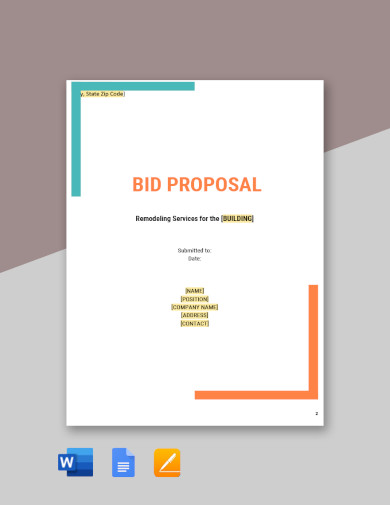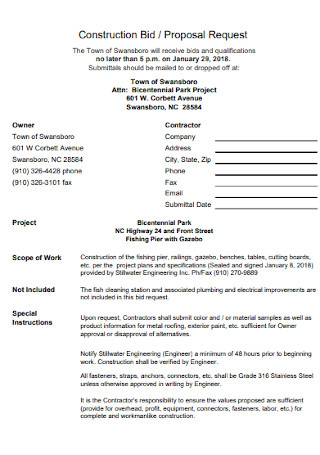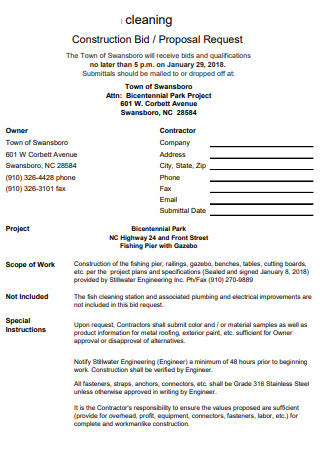25+ SAMPLE Construction Bid Proposal
-

Construction Bid Proposal
download now -

Construction Project Bid Proposal
download now -

Construction Remodeling Bid Proposal
download now -

Construction Informal Bid Proposal
download now -

Construction Marketing Bid Proposal
download now -

Construction Partnership BID Proposal
download now -

Construction Price Bid Proposal
download now -

Construction Cleaning Bid Proposal
download now -

Road Construction Bid Proposal
download now -

Design Construction of Electrical Bid Proposal
download now -

Electrical Construction Bid Proposal
download now -

Final Construction Cleaning Bid Proposal
download now -

Sample Construction Bid Proposal
download now -

Construction Bid Cleaning Proposal
download now -

Simple Construction Bid Proposal
download now -

Small Construction Bid Proposal
download now -

Construction Bid Proposal Letter
download now -

Construction Bid Proposal Agreement
download now -

Construction Bid Proposal Form
download now -

Basic Construction Bid Proposal
download now -

Construction Bid Informal Proposal Form
download now -

Construction Bid Request Proposal
download now -

Construction Bid Proposal Outline
download now -

Construction Bid Contract Proposal
download now -

General Construction Bid Proposal
download now -

Construction Bid Proposal Layout
download now
FREE Construction Bid Proposal s to Download
25+ SAMPLE Construction Bid Proposal
Definition:
Navigating the Competitive Landscape with Precision and Expertise:
Unveiling the Anatomy of a Bid Proposal:
Crafting an Irresistible Construction Bid:
Pitfalls to Avoid in Bid Proposals:
Maximizing the Impact of Your Bid Proposal:
Why is a bid proposal essential for securing construction projects?
What role do subcontractors play in a construction bid proposal?
How do construction bid proposals handle project contingencies?
Why are legal disclaimers and clauses vital in a bid proposal?
Can bid proposals be integrated with construction management software?
Definition:
A Construction Bid Proposal is a formal document presented by contractors or construction firms, detailing their qualifications, scope of work, timeline, and cost estimates for a specific project. It serves as an offer to execute the project based on specified conditions, allowing clients to evaluate and select the most suitable contractor for their construction needs.
Navigating the Competitive Landscape with Precision and Expertise:
In the vibrant ecosystem of construction, the bridge between conceptual designs and their tangible realization often lies in the hands of a compelling Construction Bid Proposal. These proposals, brimming with essential details like costs, timelines, and methodologies, serve as the foundational pillars upon which projects are awarded. Crafting a stellar bid not only showcases a firm’s prowess but also its understanding of the client’s vision, making it a crucial tool in the fiercely competitive bidding arena.
Unveiling the Anatomy of a Bid Proposal:
Delving into the anatomy of a bid proposal reveals a structured and comprehensive document designed to convey a contractor’s suitability, approach, and financial specifics for a particular construction project.
Title and Introduction:
Typically starting with a clear title indicating it’s a bid proposal, followed by a brief introduction that provides context about the bidder and the project in question.
Executive Summary:
A concise overview that captures the essence of the proposal, showcasing the contractor’s understanding of the project’s requirements and offering a snapshot of their proposed solution.
Scope of Work:
This section elucidates the specifics of what the contractor intends to accomplish. It outlines all tasks, phases, and components of the project, ensuring clarity about the deliverables.
Methodology and Approach:
Here, the contractor explains the techniques, processes, and methodologies they intend to employ. It gives insights into their work approach, ensuring the client understands their execution plan.
Project Timeline:
A projected schedule, often in the form of a Gantt chart or similar visual tool, displaying milestones, phases, and expected completion dates.
Cost Estimate and Breakdown:
A detailed financial section offering a total project cost followed by a breakdown of expenses. This section often includes labor costs, material estimates, overheads, and potential contingencies.
Team and Resources:
Information about the project team, their qualifications, and the key personnel who would be involved. Additionally, details about equipment, materials, and other resources might be included.
References and Past Projects:
A showcase of the contractor’s previous work, highlighting their experience and capability. Often, testimonials or references from past clients are included to bolster credibility.
Terms and Conditions:
This part outlines the legal and contractual specifics, ensuring both parties are aware of their rights, obligations, and the nature of their engagement.
Attachments and Appendices:
Any supplementary information, from detailed architectural plans to material specifications, can be included here for a more comprehensive understanding.
Concluding Remarks and Call to Action:
A closing section that typically reiterates the contractor’s eagerness to undertake the project and provides guidance on the next steps, like contact details or a timeline for bid acceptance.
Crafting an Irresistible Construction Bid:
Crafting an irresistible construction bid goes beyond just enumerating costs. It’s about selling the vision, competence, and reliability of a construction firm or contractor to potential clients. Here’s how to create a bid that stands out:
Deep Understanding:
Begin by immersing yourself in the project’s specifics. Understand the client’s needs, the project’s intricacies, and the potential challenges. This deep knowledge should reflect in the bid, showcasing your genuine engagement.
Transparent Pricing:
Clients appreciate transparency. Provide a clear breakdown of all costs, including materials, labor, overhead, and potential contingencies. Avoid hidden costs, which can erode trust.
Highlight Experience:
Showcase past projects, especially those similar in scope or complexity. Testimonials or references from satisfied clients can significantly bolster your bid’s appeal.
Tailored Approach:
Avoid a one-size-fits-all strategy. Tailor the proposal to the specific project, demonstrating your adaptability and commitment to meeting the unique needs of each client.
Innovative Solutions:
If there are innovative techniques or cutting-edge materials you plan to use, highlight them. These can differentiate your bid, showing that you’re forward-thinking and always seeking ways to enhance quality or efficiency.
Clear Communication:
Ensure the bid is well-structured, free of jargon, and easy to understand. Use visuals, like charts or images, to convey complex data or project timelines effectively.
Emphasize Safety:
Safety is paramount in construction. Detail your safety protocols, past safety records, and any safety certifications. This assures clients that you prioritize the well-being of workers and the project.
Sustainability and Responsibility:
If you employ sustainable practices or materials, or if you’re engaged in community-driven initiatives, highlight them. More clients now prioritize environmental and social responsibility.
Responsive and Available:
Ensure you’re available for any follow-up questions or clarifications. Quick and clear responses to queries show professionalism and keenness.
Pitfalls to Avoid in Bid Proposals:
While a well-crafted proposal can open doors to lucrative opportunities, certain missteps can lead to missed chances or even tarnish your reputation. Here are some pitfalls to avoid:
Ambiguity and Vagueness:
A proposal should offer clarity. Ambiguous statements or vague descriptions can lead to misunderstandings, eroding trust. Be precise in outlining scope, costs, and timelines.
Overpromising:
While it’s tempting to promise the moon to win a bid, overcommitting can lead to issues down the line if you can’t deliver. It’s essential to be realistic and honest about what you can achieve.
Lack of Customization:
Generic, one-size-fits-all proposals can come off as impersonal. Each bid should be tailored to the specific project and client, reflecting their unique needs and challenges.
Skipping Due Diligence:
Failing to fully understand the project can result in misaligned proposals. Thoroughly research the project, ask questions, and gather as much information as possible before drafting.
Hidden Costs:
Clients dislike surprises, especially when it comes to finances. Ensure all potential costs are upfront and transparent. Hidden or unexpected charges can sour relationships.
Ignoring Presentation:
A proposal isn’t just about content; presentation matters too. A well-organized, cleanly formatted, and professionally presented proposal can make a difference. Avoid cluttered layouts or distracting designs.
Neglecting Follow-ups:
Once a proposal is submitted, the job isn’t done. It’s vital to be proactive, follow up with clients, address their queries, and show continued interest.
Overlooking Fine Print:
Ensure that all terms, conditions, and legal aspects are clear and fair. Overlooking or neglecting contractual specifics can lead to disputes or legal challenges.
Failing to Highlight Differentiators:
What sets you apart from competitors? If you don’t clearly convey your unique value propositions, you might blend in with the crowd.
Avoiding Technology:
In this digital age, using outdated methods can be a disadvantage. Incorporating digital tools, software, or even virtual walk throughs can make your proposal more interactive and engaging.
Rushing the Process:
Crafting a winning bid proposal takes time. Rushing can lead to errors, omissions, or misjudgments. Allocate sufficient time for research, drafting, and revisions.
Maximizing the Impact of Your Bid Proposal:
Elevating the impact of your bid proposal can make the difference between blending in with the crowd and standing out as the top choice for a project. Here’s how to maximize the potency of your proposal:
1. Client-Centric Approach:
Start by understanding the client’s unique needs, concerns, and vision. Demonstrating a deep grasp of their objectives and aligning your proposal to address them can establish an immediate connection.
2. Storytelling:
Infuse your proposal with a narrative. Instead of just listing facts and figures, narrate your company’s journey, success stories, and the ways in which you’ve tackled challenges in the past.
3. Clear Visuals:
Utilize charts, infographics, and diagrams to make complex data easily digestible. Visual representations not only break up text but also convey information more compellingly.
4. Show, Don’t Just Tell:
Provide tangible evidence of your claims. This could be in the form of case studies, before-and-after photos, testimonials, or performance metrics from past projects.
5. Use Active Voice:
Write in an active voice to convey confidence and clarity. This style is direct and emphasizes the doer of the action, giving your sentences more vigor.
6. Interactive Elements:
Incorporate digital tools that allow for interactive experiences, such as virtual tours, augmented reality views of proposed projects, or clickable elements leading to additional resources.
7. Comprehensive Financials:
Be transparent and detailed about all costs. Including a clear return on investment (ROI) analysis or a value comparison can help clients understand the benefits of choosing you.
8. Highlight Innovations:
Showcase any cutting-edge techniques, materials, or technologies you plan to use. Demonstrating awareness of industry advancements can position you as a forward-thinking contender.
9. Emphasize Collaboration:
Convey your approach to teamwork and communication. Clients often value contractors who promote smooth collaboration and maintain open lines of communication throughout a project.
10. Professional Proofreading:
Errors, typos, or grammatical issues can detract from the professionalism of your proposal. Ensure your document is thoroughly proofread and polished.
11. Call to Action:
Conclude with a compelling call to action, inviting clients to reach out, ask questions, or initiate the next steps. This subtle prompt can encourage more immediate engagement.
Why is a bid proposal essential for securing construction projects?
A bid proposal is essential for securing construction projects as it demonstrates a contractor’s expertise, financial feasibility, and commitment to the project, while providing a detailed breakdown of costs, timelines, and methodologies, helping clients make informed decisions based on value and capability.
What role do subcontractors play in a construction bid proposal?
Subcontractors play a pivotal role in construction bid proposals by providing specialized expertise and cost estimates for specific project components, ensuring comprehensive project coverage and showcasing a main contractor’s ability to manage diverse aspects of construction efficiently.
How do construction bid proposals handle project contingencies?
Construction bid proposals address project contingencies by allocating a specific percentage or amount for unforeseen challenges or changes, ensuring budget flexibility, and demonstrating proactive planning for potential risks, thus enhancing client confidence in the project’s financial management.
Why are legal disclaimers and clauses vital in a bid proposal?
Legal disclaimers and clauses in a bid proposal protect both parties from potential liabilities, clarify terms and conditions, set clear boundaries, and establish mutual expectations, ensuring a transparent, binding agreement and minimizing the risk of future disputes or misunderstandings.
Can bid proposals be integrated with construction management software?
Yes, bid proposals can be integrated with construction management software. This integration streamlines the bidding process, automates documentation, ensures real-time updates, enhances communication among stakeholders, and offers a centralized platform for efficient proposal review and project management.
The Construction Bid Proposal is more than a mere document; it’s a contractor’s pledge of skill, efficiency, and dedication. As projects hinge on these proposals, their accuracy and clarity become paramount. In the competitive arena of construction, a well-structured bid not only enhances trust among stakeholders but also paves the way for successful projects, ensuring symbiotic relationships and enduring partnerships.
